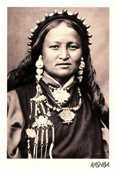Home
KASHBA Asiatica
Ais Loupatty
Ton Lankreijer
Staalstraat 6
1011 JL Amsterdam
Open 12:00 – 17:00
Zondag / Sunday 14:00 - 17:00
GESLOTEN / CLOSED
16 okt - 5 nov '25
Contact:
31-20 - 6 23 55 64
06 - 588 41 370
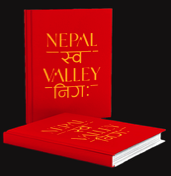
Avalokiteshvara / Chenrezig

Last November in Nepal, we came across this statue again on a floor above a workshop - it had been there since before the covid years.
The elderly sculptor, Khadga Raj Shakya, had cast four of them in the 1960s. He wanted to add a halo to the last one, but never actually got round to it.
After some time, a family member, who was in the same craft, took over the sculpture from him. However, he too did not get around to investing time and money in it.
After some thirty years, the sculptor's son bought it back, saying he would complete it. For five visits already, I had been seeing it upstairs in the storeroom - among dusty fragments and unfinished casts.
Why did it have to have a halo behind it anyway? Form and meaning actually came out even better. The embodiment of compassion was emphasised with many reaching hands and the suffering in the world was seen - it did not pass unnoticed.
Suddenly, Ais and I got the spirit to invest - and prevent 'completion'.
‘I'll give it a new patina,’ the son nodded in agreement.
- No!!! we shouted in chorus. Don't do anything about it, just leave it like that!
Experience taught us that even well-intentioned 'dusting' could result in a totally different look.
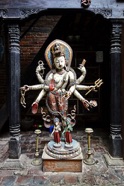
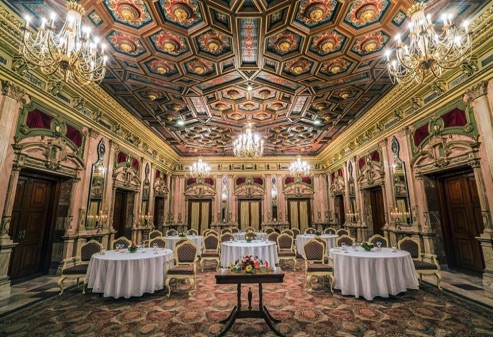

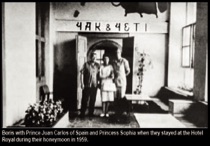
At the end of the fifties, the Yak & Yeti Hotel was set up in a former Rana palace by the dancer and chef Boris Lissanevitch.
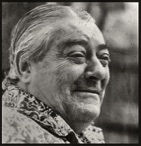


But eh… where does a statue of 185 cm fit into our gallery?
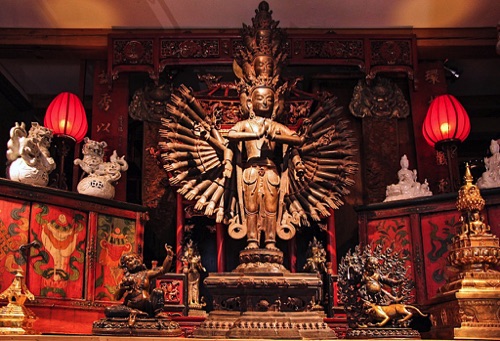

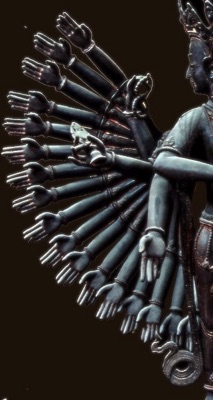
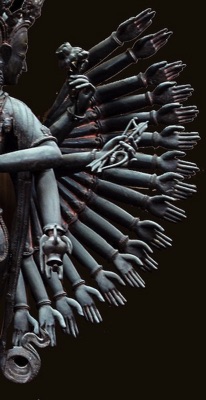
Righthand top: a rosary of 108 beads. Meditative devotion.
Righthand middle: the wheel of law that Sakyamuni’s teachings set in motion.
Righthand below: open, giving gesture.
Lefthand top: a lotus grows out of mud through dark water to the surface to unfold in sunlight. Symbol of enlightment.
Lefthand middle: bow and arrow. Attention and knowledge.
Lefthand below: waterpot. Symbol of germination.

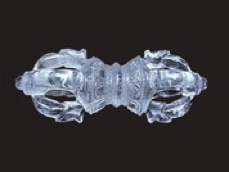
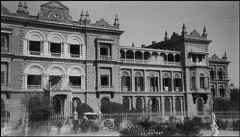
All photographs and texts ©Kashba Ais Loupatty & Ton Lankreijer.Webdesign:William Loupatty
During the covid years, many hotels had closed down or changed into a different line of business. Our trusted Tibet Guesthouse was now mainly a quarantine stop for Bengali contract workers on their way to one of the Arab countries.
One evening, in search of a somewhat safer place, we even walked into the chic Yak & Yeti hotel - a luxury, five-star heritage hotel in Kathmandu.
However, the management now turned out to be involved in organising weddings. Indian Bollywood music blared through the corridors.
But behold! At the edge of the empty, rather dark lobby, the contours of a large statue stood out - unmistakably the one we had just purchased.
During WWII he had run away from the Russian army and had initially ended up in Calcutta.
Boris - or his business partner - may have bought one of the four casts at the time, the aged sculptor does not remember.
On the entresol then. Balancing on the edge, we managed to reassemble the parts.
From years in storage to a prominent place. While retaining the old, natural patina.
Avalokiteshvara, the bodhisattva of compassion or
- as one of the three crosses in the coat of arms of her new home town symbolizes -
of mercy.
Note: To be clear, we do not trade in antique sculptures or fragments. Never have. In the past fifty years, we have seen many disappear from temples and niches - often thanks to brute force in the night.
Devotees will never sell their heritage either.
Therefore, we assume that antique statues are generally looted and - to put it in their terms - cause bad karma. For us, it is not about antiquity but about symbolism and the quality of craftsmanship.
The above Avalokiteshvara is by chance the oldest statue we ever purchased - still directly from the artist.
